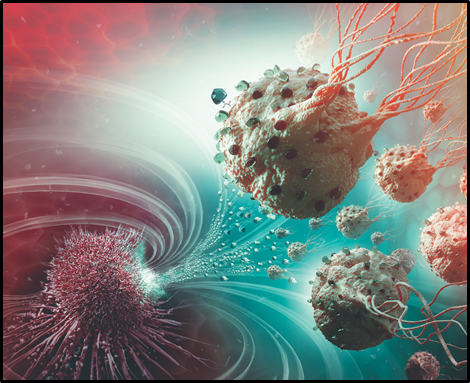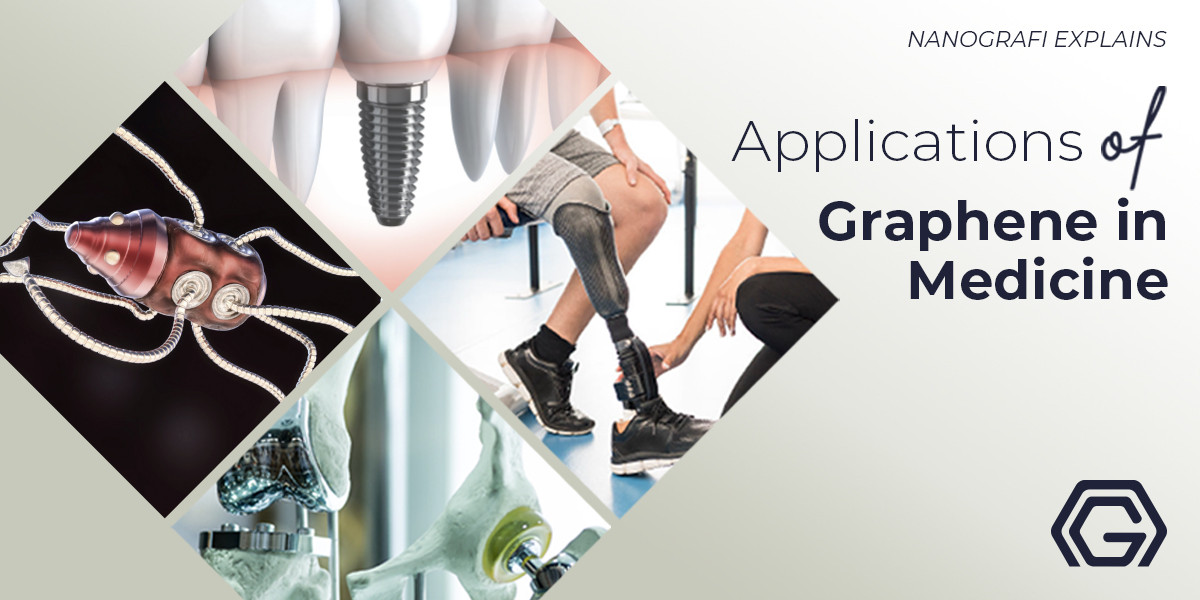Applications of Graphene in Medicine
Graphene is a novel material that has extraordinary properties, which can be used not only for the preparation of other new compounds based on it, but the possibilities are endless in various fields. The importance of this discovery was so great that the scientists who discovered it received the Nobel Prize in physics in 2010. One of the most important uses of Graphene are found in the Medical field. It has emerged as an innovative material in this sector due to its capability to treat some serious diseases such as Cancer. This article is mainly focused on the applications of Graphene in the Medical sector.
Disclaimer: The content of this post or any other linked material is intended for informational purposes only and should not be taken as medical advice.
Read All Applications of Graphene here: 60 Uses of Graphene – The Ultimate Guide to Graphene’s (Potential) Applications in 2019
Exceptional Properties of graphene
1. Among the most outstanding characteristics of this material are:
2. Extreme hardness, graphene is about two hundred times higher than that of steel.
3. Graphene’s ability to absorb energy before breaking down, as well as to withstand enormous loads, this makes graphene a worthy competitor against other materials such as diamond.
4. Graphene is a wear-resistant material as its high elasticity can significantly reduce wear resistance. This is one of the most interesting aspects of graphene’s structure.
5. Graphene has a high elasticity and it can be applied on different surfaces, which increases the durability of the surface, since being elastic, it will be less prone to breakage.
6. Graphene is almost transparent and light.
7. By having high elasticity, graphene can be molded in various ways. Graphene offers the same lightness and even greater flexibility than carbon fibers.
8. Graphene offers excellent properties as a thermal conductor.
9. Graphene reacts chemically with other substances: This allows it to serve as the basis for the creation of new materials.
10. Graphene has an antibacterial effect. Bacteria do not grow on it.
11. Graphene is also a good electrical conductor, even better than copper.
12. Graphene is a very dense material. So much so that not even the smallest known atoms, those of Helium, are capable of passing through it. But it allows the passage of water.
13. Graphene is fully capable of withstanding ionizing radiation. It offers great resistance to being modified by this type of radiation. So, it can be applied in the healthcare field.
These and many other features make this the material of the future for fields related to medical, construction, architecture and many other sectors.
Applications of Graphene in medicine

Recent researches have found multiple uses of Graphene in the medical sector as researchers have been able to determine that graphene can be used to improve treatments to fight cancer. The treatment for this type of disease has as main objective to destroy the diseased cells, affecting the healthy cells in the least possible way.
Different studies have found that the combination of graphene with different drugs and treatments has the ability to improve results. The load on the medication that reaches the cancer cells is increased, thus increasing the chances of obtaining successful treatment. But the use of this material is not only limited to this, but it is also estimated that there is a high probability of developing muscle and bone implants, based on graphene. It has numerous properties that make it very useful in medical applications.
8 applications of Graphene for medical treatments are discussed below:
1. Graphene as an Anticancer agent
Graphene is very useful to treat cancer cells, a method based on injecting the patient with graphene particles, chemically modified to adhere to cancer cells. As this material absorbs infrared light, the irradiation of the radiological treatments with which the tumor is treated acts directly on the damaged cells, without affecting the rest of the body, causing fewer side effects in the patient.
And a great example is the recent discovery of a team of researchers from the University of Illinois, who have observed how graphene can differentiate between healthy and cancerous cells, thus becoming a very interesting possible method for detecting cancer in a non-invasive way. The first test was simple as well as surprising since these scientists took samples of mouse brain cells and deposited them on a sheet of graphene, proving that it had the ability to differentiate between healthy cells and cancer cells. But how does it work?
Everything is based on the hyperactivity of tumor cells, which show great electrical activity. Therefore, as graphene is an excellent conductor of electricity when it comes into contact with one of these cells, it collects a large number of electrons, which significantly changes the vibration energy of its carbon atoms.
Logically, this cannot be verified with the naked eye, but it can be easily detected with the help of high-resolution vibration energy maps, due to which these researchers managed to successfully differentiate healthy cells from cancer cells.
It will still be necessary to carry out new tests to be sure of the effectiveness of graphene to detect cancer, but for now, all the signs seem to be very positive. Hopefully, it can really be applied, as the first step in fighting disease as terrible as cancer is to detect it as soon as possible. Graphene has the capability to develop diagnostic tools, against cancer or tissues.
2. Graphene in Implants
Due to the biocompatibility of Graphene, it converts light into electrical impulses that are transmitted to the brain through the optic nerve, transforming the signal into images. Neural implants replace damaged organic tissues when nerve cells function basically by means of an electric current. Graphene can be a replacement for injured nerve circuits.
3. Graphene in Dental Implants
This research was initiated at the University of Alicante. The professionals evaluated the feasibility of incorporating graphene to materials related to dental implants, to increase its durability. The research emerged as an alternative to solve the shortages of materials used in the manufacture of dental implants. The objective was to develop resins and composite materials that incorporated graphene in their composition. From the results of the study, graphene was incorporated as a material associated with dental implants.
Later studies look for new applications of the material. One conducted at the Chalmers University of Technology in Sweden used graphene to create a layer of vertical splinters. They managed to form a protective surface in dental implants. This prevented bacteria from clinging to it. The objective was to protect the patient against infections, eliminate the application of antibiotics and reduce the risk of treatment rejection. Prostheses placed on dental implants processed with graphene have greater resistance as well as greater structural stability and flexibility. In addition to being lighter and more flexible. The durability of this treatment is a priority for all dentists specialized in implantology and also for patients. The commitment to nanotechnology in the dental sector by creating polymers with graphene for biological use may help to increase the success of the treatment as requested by dental implants.
4. Graphene as a Therapeutic tool
Graphene oxide, the oxidized form of graphene, is a carbon substance that could be used in medicine as a novel diagnostic and therapeutic tool. Previous studies have highlighted the importance of Graphene as a medical tool. Before explaining it as a Threptic tool, an essential requirement is to understand how Graphene interacts with the immune cells that protect our body from intruders. They develop nanoscopic 'bricks' to tame the light and change color. Researchers from the universities of Sassari and Rome Tor Vergata (Italy), the French CNRS and other European centers have portrayed in the laboratory the complex interactions between graphene oxide and fifteen types of cells of our immune system, such as T lymphocytes, leukocytes, monocytes, NK cells, and dendritic cells.
The study data, published in Nature Communications, highlight the importance of functionalizing it (adding other molecules, such as amino groups, such as those of medicine) to its surface so that they are more compatible with human defense cells. Thus, researchers have found that graphene functionalized with amino groups increases its biocompatibility with respect to normal graphene oxide.
Researchers are facing a starting point to develop biomedical platforms based on this material on a nanometric scale, such as new immunotherapies, vaccine carriers, and nanoadjuvants. Graphene nanomaterials are easy to combine with medications and other molecules in its surface, improving the function of the drug and the specificity on the objective of interest. In the future, blood injectable nanomaterials could be designed so that they could attach to certain cells without defenses attacking the intruder. Using immunogenomic and protein data, the objective is to be able to use graphene safely in medicine and in any other field, minimizing its effects on health and the environment. Currently, its impact is analyzed not only in human cells but also in pigs, mice, and the C. Elegans worm.
5. Graphene in Prosthesis
Graphene on rubber makes it an ideal material for an efficient bionic muscle since the electrical stimulation on this compound makes it possible to control tension and relaxation. Graphene is useful for making splints (in which aluminum, steel or titanium is used today) to achieve the necessary hardness and strength.
6. Graphene in Water Purification
Graphene sheets are more efficient and cheaper for purifying water efficiently. These sheets don’t allow the impurities to pass through it but allow water to pass through it. The use of Graphene for Water Purification has been explained earlier and this is an important application to provide clear and pure water to the people of the world who do not have the access to clean water and are affected by various diseases.
7. Graphene in DNA sequencing
By improving the study of diseases of genetic origin, this membrane-converted material can be submerged in the conductive fluid and apply energy voltage to extract the DNA through the tiny pores in the graphene.
8. Graphene as a Biomarker
Graphene acts as a sensor for blood pressure, blood sugar levels and nitric oxide in oxygen. It also acts as a sensor in the dental field with carefully constructed peptides, which detects bacteria individually, determining the kind of pathology that makes us sick. It is an immunosensor that allows you to detect infinitesimal amounts of some substances such as growth hormone.
Read: Ultimate Guide to Graphene: Everything You Need to Know About Graphene
Thus, Graphene is a blessing for the medical sector as it has proved to be useful against various disease, more importantly against Cancer. Researchers are still working on exploring more applications of Graphene in the medical field. Graphene is important to improve applications in medicine: cancer therapies, disease diagnostic tools, tissue engineering, implants, DNA sequencing, biomarker, transfer of genetic material, as well as in the combined field of biomedical imaging and neuroscience.
Recent Posts
-
Reducing the Carbon Footprint of Nanomaterials
The production of nanomaterials is vital for numerous advanced applications, from healthcare to elec …26th Apr 2024 -
Nanocomposites in Food Packaging
The utilization of nanocomposites in food packaging represents a significant advancement in the fiel …19th Apr 2024 -
What is the Difference Between 7075 and 6061 Aluminum Alloy?
When comparing 7075 aluminum alloy to 6061 aluminum alloy, it's essential to understand their disti …5th Apr 2024








